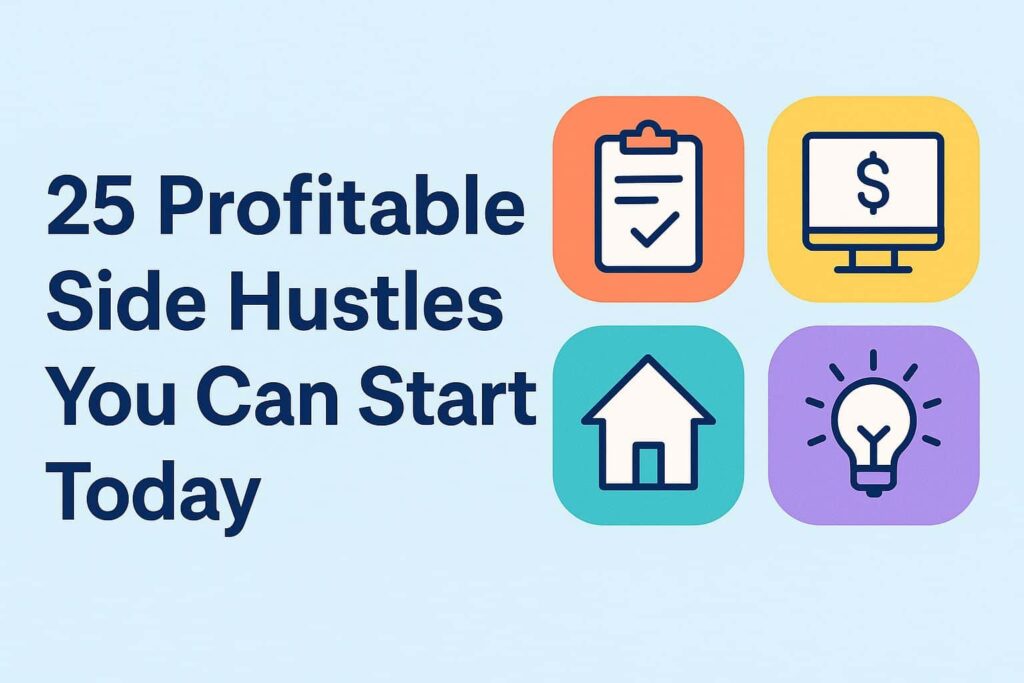The Rise of Etsy Side Hustles
In recent years, handmade and customized products have experienced an impressive resurgence. Consumers are seeking unique, authentic items that reflect individuality and craftsmanship something mass production simply cannot replicate. Platforms like Etsy have become the global hub for this new wave of small scale entrepreneurship, allowing artists, designers, and hobbyists to turn their creativity into income.
As of 2025, thousands of Americans are using Etsy not only as a hobby platform but as a serious side hustle a flexible, scalable way to earn money online. From home-based candle makers to digital print designers, Etsy offers nearly limitless opportunities for creative individuals to monetize their skills. But what exactly is driving this boom, and how do sellers stay compliant with U.S. laws and taxes? Let’s explore.
- Why Etsy Side Hustles Are Gaining Popularity
1.1 Low Startup Costs and Easy Entry
Starting an Etsy shop requires very little upfront investment. There’s no need for physical storefronts, warehouse space, or expensive inventory systems. Listing fees and transaction commissions exist, but they are manageable even for beginners. This makes Etsy one of the most accessible online business models for aspiring entrepreneurs.
1.2 Global Reach and Built In Audience
Etsy attracts millions of buyers from the United States, Canada, the United Kingdom, Australia, and beyond. Sellers can reach an international customer base without needing their own e commerce infrastructure. With integrated payment processing, shipping options, and automatic currency conversion, Etsy simplifies global sales for small businesses.
1.3 Growing Demand for Personalized and Handmade Goods
Since the pandemic, consumer preferences have shifted dramatically toward handmade, eco friendly, and custom products. People now value authenticity and personal touch more than ever. This demand fuels niche markets from minimalist jewelry and boho home décor to personalized gifts and digital wall art creating steady opportunities for Etsy sellers.
1.4 The Power of Social Media and Influencer Marketing
Social media platforms like Instagram, TikTok, and Pinterest have become major growth drivers for Etsy entrepreneurs. A single viral post can lead to thousands of sales overnight. Sellers who effectively use hashtags, short videos, and influencer partnerships can achieve organic visibility that traditional marketing would never match.
1.5 Supportive Platform Tools and Analytics
Etsy’s built in analytics, advertising tools, and SEO features make it easier to understand what sells and why. Sellers can analyze performance, target specific keywords, and optimize listings. These tools help part time hustlers run professional level online stores with minimal technical skills.
- The Legal Side: Running an Etsy Side Hustle in the United States
While Etsy offers an exciting opportunity to earn extra income, it’s important to remember that it is still a business activity and that means certain legal obligations apply. Let’s look at the key legal and tax considerations for U.S. Etsy sellers.
2.1 Business or Hobby? The IRS Distinction
The Internal Revenue Service (IRS) classifies income differently depending on whether you operate a business or a hobby.
• If your primary goal is profit, you’re running a business.
• If you occasionally sell items without consistent profit motives, it may be considered a hobby.
However, even hobby income must be reported. The IRS expects individuals to declare all earnings from Etsy, regardless of size. If your net earnings exceed $400 per year, you may also owe self-employment tax.
👉 Source: IRS Hobby vs. Business Guidelines
2.2 Federal Income and Self Employment Taxes
Etsy sellers typically pay two main types of federal tax:
1. Income Tax – Based on your overall taxable income after deducting business expenses such as materials, packaging, and listing fees.
2. Self Employment Tax – Covers Social Security and Medicare contributions, applicable when net profits exceed $400 annually.
Many Etsy sellers file using Schedule C (Form 1040) to report business profits and losses. Tools like QuickBooks Self Employed or TurboTax can automate much of this process for side hustlers.
2.3 State Sales Tax Obligations
Most U.S. states require sellers to collect sales tax on items shipped to customers within the same state. Thankfully, Etsy simplifies this through automatic sales tax collection and remittance for most jurisdictions. However, it’s the seller’s responsibility to verify that their state’s requirements are being met.
For example:
• If you live in California and sell to a California customer, sales tax applies.
• If you sell to another state, Etsy may handle tax collection automatically depending on that state’s nexus laws.
👉 Check your state’s Department of Revenue website to stay compliant.
2.4 Business Licenses and Local Regulations
Some cities or counties may require small business licenses or home based business permits even for online sellers. These rules vary widely depending on location.
If you’re producing candles, soaps, or cosmetics, you may also need FDA compliance or labeling standards. Similarly, if you sell children’s toys or clothing, the Consumer Product Safety Commission (CPSC) requires safety labeling and testing compliance.
Pro tip: Before starting, check your local small business administration (SBA) office for guidance on permits and licenses.
2.5 Copyright and Trademark Protection
Etsy takes intellectual property seriously. Using copyrighted images, brand logos, or licensed characters without permission can lead to account suspension or legal penalties.
To stay compliant:
• Only use original designs or assets you have rights to.
• Avoid using words like “Disney,” “Marvel,” or “Starbucks” in product titles.
• Consider trademarking your brand name if you plan to grow your Etsy store long-term.
- Practical Steps to Build a Successful and Legal Etsy Side Hustle
3.1 Choose a Profitable Niche
Research categories with consistent demand but manageable competition. Popular 2025 niches include:
• Printable planners and digital art
• Personalized jewelry
• Eco friendly home décor
• Pet accessories
• Wedding and event stationery
Use Etsy search data and Google Trends to identify profitable keyword opportunities.
3.2 Register Your Business (Optional but Recommended)
Even though you can sell as a sole proprietor, forming an LLC (Limited Liability Company) can protect your personal assets and simplify tax reporting. It also enhances credibility if you expand into wholesale or brand collaborations later.
3.3 Keep Accurate Financial Records
Use a simple accounting tool or spreadsheet to track:
• Gross sales and Etsy payouts
• Materials and supply costs
• Shipping and packaging expenses
• Platform fees and advertising costs
Maintaining organized records helps at tax time and ensures you claim all eligible deductions.
3.4 Build Brand Presence
Etsy success often depends on storytelling. Invest time in:
• A professional shop banner and logo
• Clear product photography
• Engaging product descriptions with SEO friendly keywords
• Responsive communication with buyers
Your brand identity should convey trust and authenticity.
3.5 Diversify Traffic Sources
While Etsy provides built in traffic, external channels can greatly boost visibility:
• Pinterest: Create visually rich pins linking to your listings.
• TikTok: Share short videos showcasing your creative process.
• Instagram: Use reels and stories to build emotional connection with your audience.
• Email Marketing: Collect emails from loyal customers for promotions and updates.
3.6 Stay Updated with Legal and Tax Changes
Etsy and U.S. tax regulations evolve regularly. Subscribe to Etsy’s Seller Handbook, the IRS small business newsletter, or local business workshops to stay current. Ignoring updates can lead to missed deductions or compliance issues.
- The Future of Etsy Side Hustles
Etsy’s growth trajectory shows no signs of slowing. The platform now hosts over 9 million active sellers and more than 90 million buyers worldwide. Economic uncertainty, remote work flexibility, and AI-powered tools make online side hustles even more appealing.
Emerging trends include:
• AI generated design templates and digital art
• Eco conscious handmade products
• Personalized print on demand businesses
• Subscription boxes and micro brands
For U.S. residents, Etsy offers a bridge between creative passion and financial independence as long as sellers follow the right legal and tax framework.
Creativity Meets Compliance
The surge in Etsy side hustles reflects more than just a business trend it’s part of a cultural shift toward independence, authenticity, and flexible income. With minimal startup costs, a massive global audience, and supportive tools, Etsy empowers anyone with creativity and discipline to earn legitimately from home.
However, treating your shop as a real business by understanding taxes, obtaining necessary permits, and respecting intellectual property will separate long term success from short term experimentation.
If managed wisely, your Etsy side hustle can grow from a weekend project into a reliable source of income, combining creativity, entrepreneurship, and legal compliance in perfect harmony.
You can read another article in the Digital Assets category.


